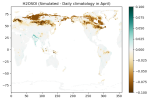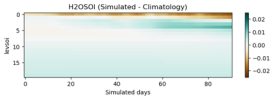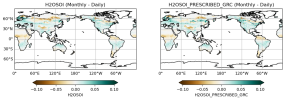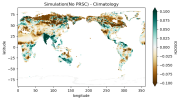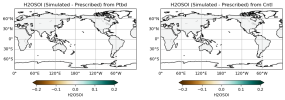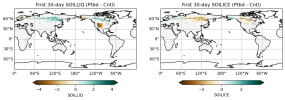Hi,
I'm running prescribed soil moisture experiments and want the model to stick to the prescribed values rather than actively evolve over time. We conducted two experiments on Derecho prescribing monthly and daily soil moisture data, where the daily values were interpolated from the monthly data. The model was run from April to June.
However, both experiments share a similar issue of rapid drying of soil moisture in the high latitude regions.
I expected the simulated soil moisture values to closely match the prescribed values. But the result concerning as there is a significant difference in the high-latitude regions. Is this because CLM allows soil moisture to evolve through hydrological processes? Still, the deviation seems too large, and surface soil moisture in high-latitude regions is depleting too quickly.
Could someone help me understand what I might be missing?
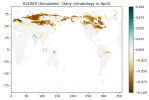
Differences in surface soil moisture (H2OSOI, levsoi=0) averaged over the first 30 days.

Globally averaged differences in soil moisture.
How can we enforce the prescribed soil moisture and prevent the model from diverging?
Would modifying the source code—such as repeatedly calling PrescribedSoilMoistureInterp after any subroutine alters soil moisture—help achieve this?
Any insights would be greatly appreciated!
Below is the information about my simulation setup and changes I've made.
CESM version: CESM2.2.2
Compset: FHIST (HIST_CAM60_CLM50%SP_CICE%PRES_DOCN%DOM_MOSART_SGLC_SWAV_SIAC_SESP)
user_nl_clm
use_soil_moisture_streams = .true.
stream_fldfilename_soilm = ‘/path/to/soil_moisture_data/LFMIP-pdLC-SST.H2OSOI.0.9x1.25.20levsoi.natveg.1980-2014.MONS_climo.c190716.nc’
soilm_ignore_data_if_missing = .true.
env_run.xml
CLM_BLDNML_OPTS: -bgc sp -ignore_warnings
soil moisture data: LFMIP-pdLC-SST.H2OSOI.0.9x1.25.20levsoi.natveg.1980-2014.MONS_climo.c190716.nc
BalanceCheckMode.F90
blocked calling endrun at line 470
! call endrun(decomp_index=indexc, clmlevel=namec, msg=errmsg(sourcefile, __LINE__))
I'm running prescribed soil moisture experiments and want the model to stick to the prescribed values rather than actively evolve over time. We conducted two experiments on Derecho prescribing monthly and daily soil moisture data, where the daily values were interpolated from the monthly data. The model was run from April to June.
However, both experiments share a similar issue of rapid drying of soil moisture in the high latitude regions.
I expected the simulated soil moisture values to closely match the prescribed values. But the result concerning as there is a significant difference in the high-latitude regions. Is this because CLM allows soil moisture to evolve through hydrological processes? Still, the deviation seems too large, and surface soil moisture in high-latitude regions is depleting too quickly.
Could someone help me understand what I might be missing?

Differences in surface soil moisture (H2OSOI, levsoi=0) averaged over the first 30 days.

Globally averaged differences in soil moisture.
How can we enforce the prescribed soil moisture and prevent the model from diverging?
Would modifying the source code—such as repeatedly calling PrescribedSoilMoistureInterp after any subroutine alters soil moisture—help achieve this?
Any insights would be greatly appreciated!
Below is the information about my simulation setup and changes I've made.
CESM version: CESM2.2.2
Compset: FHIST (HIST_CAM60_CLM50%SP_CICE%PRES_DOCN%DOM_MOSART_SGLC_SWAV_SIAC_SESP)
user_nl_clm
use_soil_moisture_streams = .true.
stream_fldfilename_soilm = ‘/path/to/soil_moisture_data/LFMIP-pdLC-SST.H2OSOI.0.9x1.25.20levsoi.natveg.1980-2014.MONS_climo.c190716.nc’
soilm_ignore_data_if_missing = .true.
env_run.xml
CLM_BLDNML_OPTS: -bgc sp -ignore_warnings
soil moisture data: LFMIP-pdLC-SST.H2OSOI.0.9x1.25.20levsoi.natveg.1980-2014.MONS_climo.c190716.nc
BalanceCheckMode.F90
blocked calling endrun at line 470
! call endrun(decomp_index=indexc, clmlevel=namec, msg=errmsg(sourcefile, __LINE__))

